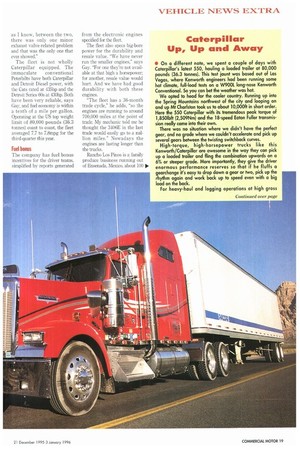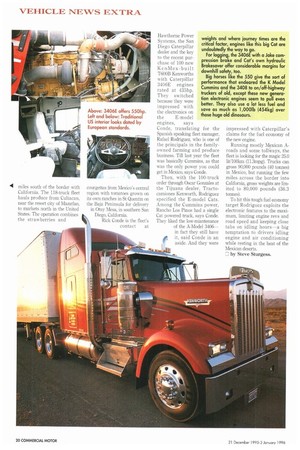West Coast trips test Cat
Page 20

Page 21

Page 22

If you've noticed an error in this article please click here to report it so we can fix it.
• Since November of this year the 10.3-litre Cat 3176B electronically controlled straight-six has been optional in Foden's 3000 Series (CM 7-13 September). And in October 1996 operators can look forward to the arrival of the 14-litre 3406E engine which is currently offered in Australia and the United States rated at up to 550hp.
Commercial Motor will be testing a 3176-engined Foden just as soon as we can lay our hands on one, probably in February, but it will be a while before we see a 14-litre Cat-powered Foden on British roads.
Rather than wait we asked our US correspondent Steve Sturgess to track down some operators running with the yellow engine; he also sneaked in a ride with the stump-pulling 550hp version. So what can British hauliers expect from the latest all-electronic big Cats?
Durability and resale value are major concerns of BDR Transport, a less-than-truckload carrier with a unique operation consolidating California-bound freight out of the New England states at its Bellows Falls, Vermont terminal. Cargo is destined for distribution from the company's two terminals in California. At the same time, freight is consolidated in California and shipped in the reverse direction to Vermont.
The small family company was started by brothers Gilbert and Richard Gay in 1970 and today is run by Gilbert's son Greg. It runs 34 trucks, all Peterbilts: 17 are used in the regional operations and 17 for line-haul. Running coast to coast, the line-haul units cover a distance of 3,080 miles from headquarters in Vermont to the Modesto, California terminal. Company president and chief executive Greg Gay says that those line-haul trucks really haul, averaging around 233,000 miles (375,000km) a year; equal to 38 coast-to-coast turnarounds.
This high-mileage fleet was selected by Caterpillar as one of the test sites for the evaluation of the 3406E before the engine was released for sale. The first experimental engine ran 140,000 miles (225,000km) before it was pulled from the chassis and torn down by Caterpillar engineers. Gay says: "We have just sold the truck with the second engine at 836,000 miles, so the second engine ran 690,000 miles. As far as I know, between the two, there was only one minor exhaust valve-related problem and that was the only one that ever showed."
The fleet is not wholly Caterpillar equipped. The immaculate conventional Peterbilts have both Caterpillar and Detroit Diesel power, with the Cats rated at 435hp and the Detroit Series 60s at 430hp. Both have been very reliable, says Gay, and fuel economy is within a tenth of a mile per gallon. Operating at the US top weight limit of 80,000 pounds (36.3 tonnes) coast to coast, the fleet averaged 7.7 to 7.8mpg for the third quarter this year.
Fuel bonus
The company has fuel bonus incentives for the driver teams, simplified by reports generated from the electronic engines specified for the fleet.
The fleet also specs big-bore power for the durability and resale value. "We have never run the smaller engines," says Gay. "For one they're not available at that high a horsepower, for another, resale value would hurt. And we have had good durability with both thee engines.
"The fleet has a 36-month trade cycle," he adds, "so the engines are running to around 700,000 miles at the point of trade. My mechanic told me he thought the 3406E in the last trade would easily go to a million miles." Nowadays the engines are lasting longer than the trucks.
Rancho Los Pinos is a family produce business running out of Ensenada, Mexico, about 100 to.
41 miles south of the border with California. The 118-truck fleet hauls produce from Culiacan, near the resort city of Mazatlan. to markets north in the United States. The operation combines the strawberries and
courgettes from Mexico's central region with tomatoes grown on its own ranches in St Quentin on the Baja Peninsula for delivery in Otay Mesa, in southern San Diego, California.
Rick Conde is the fleet's contact at
Hawthorne Power Systems, the San Diego Caterpillar dealer and the key to the recent purchase of 100 new KenMex-built T600B Kenworths with Caterpillar 3406E engines rated at 435hp, They switched because they were impressed with the electronics on
the E-model engines, says Conde, translating for the Spanish speaking fleet manager, Rafael Rodriguez, who is one of the principals in the familyowned farming and produce business. Till last year the fleet was basically Cummins. as that was the only power you could get in Mexico, says Conde.
Then, with the 100-truck order through Oscar Gonzales at the Tijuana dealer, Tractocamiones Kenworth, Rodriguez specified the E-model Cats. Among the Cummins power, Rancho Los Pinos had a single Cat powered truck, says Conde. They liked the low-miantenance
of the A-Model 3406— in fact they still have it, said Conde in an aside. And they were impressed with Caterpillar's claims for the fuel economy of the new engine.
Running mostly Mexican Aroads and some tollways, the fleet is looking for the magic 25.0 lit/100km (11.3mpg). Trucks can gross 90,000 pounds (40 tonnes) in Mexico, but running the few miles across the border into California, gross weights are limited to 80,000 pounds (36.3 tonnes).
To hit this tough fuel economy target Rodriguez exploits the electronic features to the maximum, limiting engine revs and road speed and keeping close tabs on idling hours—a big temptation to drivers idling engine and air conditioning while resting in the heat of the Mexican deserts.
7 by Steve Sturgess.




























































































































